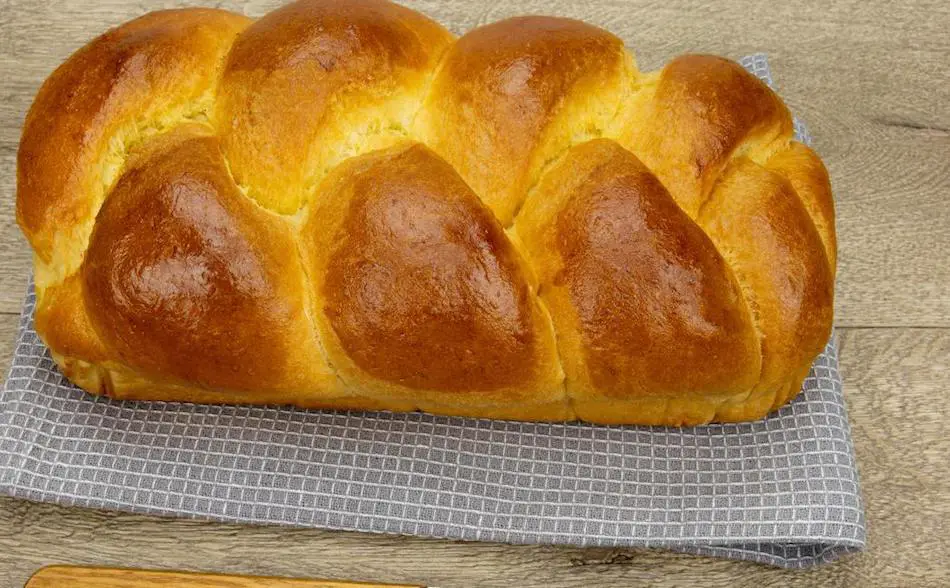
Brioche is a rich, buttery and delicious bread that has been enjoyed for centuries in France. This classic bread can be made with various types of flour, but using all-purpose flour makes the process much simpler and accessible for home bakers. This article will provide a comprehensive guide to making all-purpose flour brioche, from the ingredients and equipment needed to the step-by-step instructions.
All-purpose flour brioche is a type of rich and buttery bread that is made using all-purpose flour, sugar, yeast, eggs, and butter. The dough is usually enriched with large amounts of butter, which results in a tender and soft texture. To make all-purpose flour brioche, start by mixing the yeast, sugar, and warm milk in a bowl. Then, add the eggs, salt, and all-purpose flour to the mixture and knead until you have a smooth and elastic dough. Finally, incorporate the softened butter and continue to knead until it is fully incorporated. Allow the dough to rise until doubled in size, shape into desired forms, let it rise again and then bake in the oven until golden brown.
Recipe for All-Purpose Flour Brioche
| Ingredients | Quantity |
|---|---|
| All-Purpose Flour | 3 1/2 cups |
| Sugar | 3 tablespoons |
| Active Dry Yeast | 2 1/4 teaspoons |
| Warm Milk | 1/2 cup |
| Salt | 1 teaspoon |
| Eggs | 4 |
| Unsalted Butter, softened | 1 cup |
| Instructions |
|---|
| 1. In a large bowl, mix together the yeast, sugar, and warm milk. Let sit for 5 minutes or until the mixture starts to foam. |
| 2. Add the eggs, salt, and 2 cups of all-purpose flour to the yeast mixture. Mix until well combined. |
| 3. Using a stand mixer or your hands, knead in the remaining 1 1/2 cups of all-purpose flour until the dough is smooth and elastic. |
| 4. Slowly incorporate the softened butter into the dough, kneading until it is fully incorporated. |
| 5. Place the dough in a greased bowl, cover with plastic wrap, and let rise in a warm, draft-free environment until doubled in size (about 1 hour). |
| 6. Punch down the dough and shape into the desired form. Place in a greased baking dish, cover, and let rise again until doubled in size (about 45 minutes). |
| 7. Preheat oven to 375°F. Bake the brioche for 20-25 minutes or until golden brown and the internal temperature reaches 190°F. |
| 8. Remove from the oven and let cool before serving. Enjoy your delicious all-purpose flour brioche! |
Gathering the Ingredients
Gathering the right ingredients is the first step to making a delicious all-purpose flour brioche. Here’s what you’ll need:
- All-Purpose Flour: Choose high-quality all-purpose flour for best results.
- Sugar: Use granulated sugar for the dough and a little extra for the egg wash.
- Salt: A pinch of salt helps bring out the flavors in the dough.
- Yeast: Fresh or active dry yeast can be used, but make sure it is fresh for best results.
- Eggs: Room temperature eggs will help the dough rise better.
- Milk: Warm milk helps activate the yeast and creates a tender, fluffy brioche.
- Unsalted Butter: Softened butter will mix into the dough easily and add richness and flavor.
Make sure to measure the ingredients precisely and have everything ready before starting the recipe.
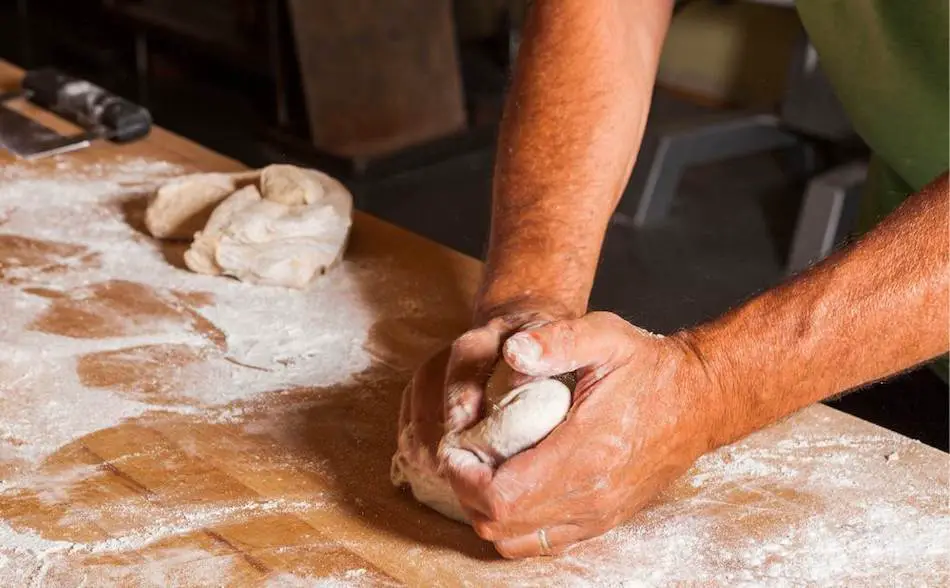
Making the Dough
Making the dough for a rich and tender all-purpose flour brioche requires patience, precision, and a bit of elbow grease. Here are the steps to follow:
- Combine the ingredients: In a large mixing bowl, whisk together the flour, sugar, salt, yeast, eggs, and warm milk until a rough dough forms.
- Knead the dough: Turn the dough out onto a lightly floured surface and knead for 5 to 10 minutes, or until smooth and elastic.
- Rise the dough: Place the dough in a greased bowl, cover with plastic wrap, and let it rise in a warm, draft-free place until doubled in size.
- Fold the dough: Once the dough has risen, gently deflate it and fold it several times to strengthen the gluten structure.
Proofing the Dough
Proofing the dough for a tender and flavorful all-purpose flour brioche is a critical step in the baking process. Here’s how to do it:
- Preheat the oven: Preheat your oven to 200°F (93°C), then turn it off. This warm environment is ideal for proofing the dough.
- Grease a bowl: Grease a large mixing bowl and place the dough inside. Cover it with plastic wrap.
- Let it rise: Let the dough rise in the warm, preheated oven until doubled in size, which will take about 45 minutes to an hour.
- Check for doneness: Once the dough has risen, gently press a finger into it. If the indentation remains, the dough is ready. If it springs back, let it continue rising until it passes the test.
Proofing the dough is essential for developing the flavor and texture of the brioche. The yeast will produce carbon dioxide, causing the dough to rise and become light and airy.
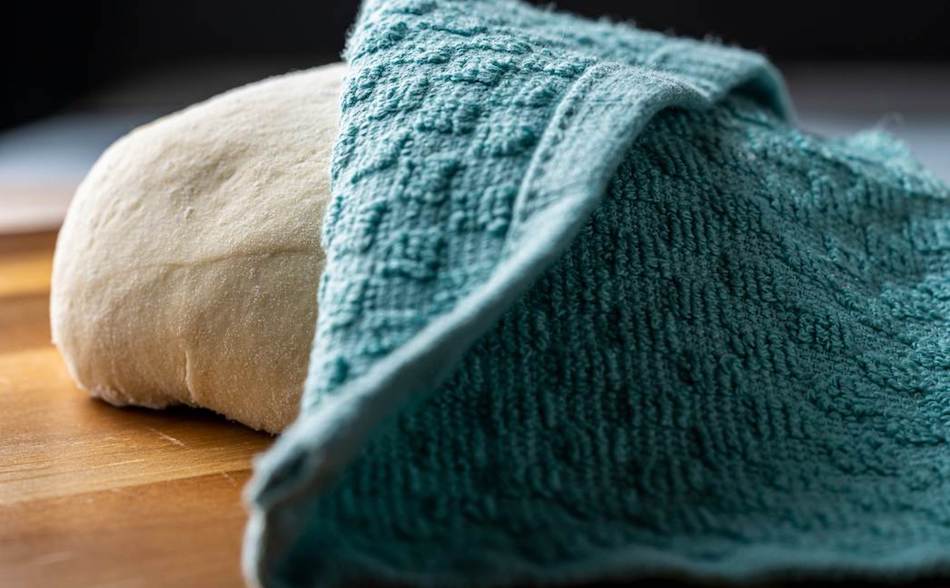
Adding the Butter
Adding the butter to the dough is a key step in making a rich and flavorful all-purpose flour brioche. Here’s how to do it:
- Soften the butter: Make sure the butter is soft, but not melted, for best results. You can soften it by leaving it out at room temperature or microwaving it for a few seconds.
- Incorporate the butter: Once the dough has been kneaded and risen, add the softened butter to the bowl. Use a spatula or a dough scraper to mix the butter into the dough until it is completely incorporated and the dough is smooth and elastic.
- Repeat the rising process: After incorporating the butter, cover the bowl with plastic wrap and let the dough rise until doubled in size.
- Shaping the Brioche
- Shaping the brioche dough is the final step before baking and it’s an important one as it affects the final appearance of the loaf. Here’s how to shape brioche with all-purpose flour:
- Deflate the dough: After the dough has risen, gently deflate it by pressing down on it with your hands.
- Divide the dough: Divide the dough into equal portions, depending on the size of the brioche you want to make. For example, for individual brioches, divide the dough into 10-12 pieces, while for a large loaf, divide it into two pieces.
- Shape the dough: Roll each piece of dough into a tight ball and place it in a greased brioche pan or on a baking sheet lined with parchment paper. For a traditional brioche loaf, shape the dough into a round or oval shape.
- Let it rise: Once the brioche has been shaped, cover it with a clean kitchen towel and let it rise for about 30 minutes, or until doubled in size.
- With these steps, you’ll achieve a beautifully shaped brioche that will bake up perfectly in the oven.
Egg Washing the Brioche
Egg washing the brioche before baking is an important step that gives the loaf a glossy, golden appearance and helps the crust to form. Here’s how to do it:
- Whisk the egg: In a small bowl, whisk together one egg and one tablespoon of water.
- Brush the brioche: Using a pastry brush, gently brush the egg mixture over the surface of the shaped and risen brioche.
- Sprinkle with toppings: If desired, sprinkle the brioche with coarse salt, sesame seeds, or other toppings of your choice.
Baking the Brioche
Baking the brioche is the final step in making a delicious and perfectly baked loaf of all-purpose flour brioche. Here’s how to do it:
- Preheat the oven: Preheat your oven to 375°F (190°C).
- Bake the brioche: Place the shaped and egg washed brioche in the oven and bake for 20-25 minutes, or until the crust is golden brown and the internal temperature of the brioche reaches 190°F (88°C).
- Check for doneness: To check for doneness, gently tap the bottom of the brioche. It should sound hollow. You can also use a thermometer to check the internal temperature of the brioche.
- Cool the brioche: Once the brioche is fully baked, remove it from the oven and transfer it to a wire rack to cool completely.
Cooling the Brioche
Cooling the brioche is an important step that allows the loaf to set and prevents it from becoming tough or dense. Here’s how to do it:
- Remove from the oven: Once the brioche is fully baked, remove it from the oven and transfer it to a wire rack.
- Let it cool: Allow the brioche to cool completely on the wire rack, typically for 30-45 minutes.
- Store properly: Once the brioche has cooled, you can store it in an airtight container at room temperature for up to 3 days or in the refrigerator for up to 5 days.
Storing and Serving Tips
Storing and serving brioche made with all-purpose flour is easy and straightforward, but there are a few tips that can help ensure that the loaf stays fresh and delicious. Here are a few suggestions:
- Store at room temperature: Brioche can be stored in an airtight container at room temperature for up to 3 days.
- Store in the refrigerator: If you prefer, you can also store the brioche in the refrigerator for up to 5 days.
- Reheat the brioche: If you’d like to enjoy a warm slice of brioche, simply slice it and warm it in a toaster or oven.
- Serve with toppings: Brioche is delicious on its own, but it can also be served with butter, jam, or other spreads of your choice.
Achieving a Perfect Texture with All-Purpose Flour
Achieving the perfect texture in your brioche loaf is essential to making a rich, tender, and delicious bread. And using all-purpose flour can help you achieve just that. Here are a few tips to ensure that you get the best results:
- Knead the dough properly: Kneading the dough thoroughly helps to develop the gluten, which gives the brioche its characteristic tender and fluffy texture. Make sure to knead the dough for at least 10 minutes, or until it is smooth and elastic.
- Use a stand mixer: If you have a stand mixer, use it to make the dough. This will make the kneading process easier and quicker, giving you the perfect texture every time.
- Don’t over-proof the dough: Over-proofing the dough can cause the brioche to collapse and become dense. Make sure to proof the dough until it has doubled in size, but no more.
- Use room temperature ingredients: Make sure to use room temperature ingredients, including the all-purpose flour, eggs, milk, and yeast. This will help to ensure that the dough rises evenly and to the correct size.
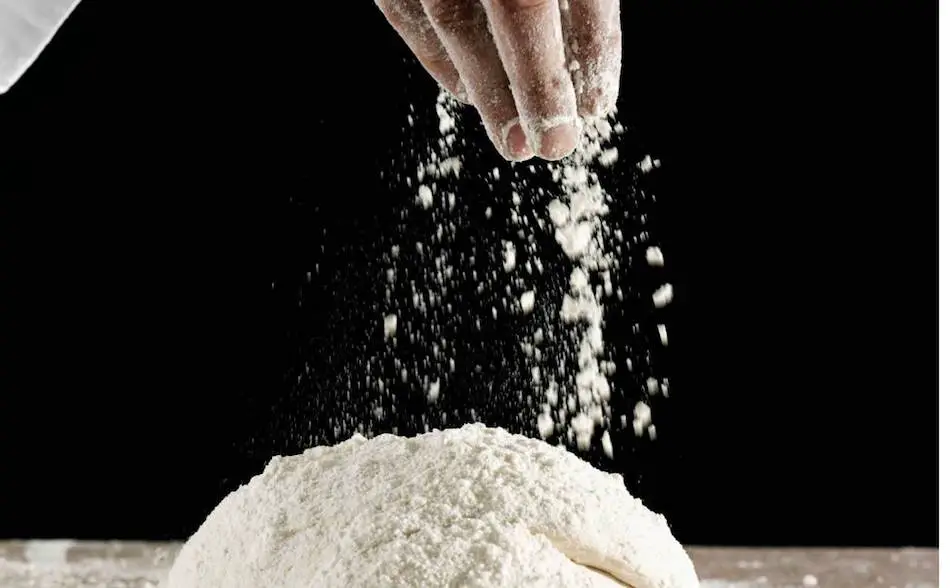
FAQs about all purpose flour and Brioche
Here are some frequently asked questions about making brioche with all-purpose flour:
- Can I use bread flour instead of all-purpose flour? Yes, you can use bread flour instead of all-purpose flour, but keep in mind that the final product may be slightly denser and chewier.
- Can I make brioche with gluten-free flour? No, brioche is not suitable for gluten-free diets, as it contains wheat flour.
- How do I know when the dough has been kneaded enough? The dough is ready when it is smooth, elastic, and no longer sticks to the sides of the bowl.
- How long does it take for the dough to double in size? This depends on the temperature and humidity in your kitchen, but it usually takes around 1-2 hours.
- Can I refrigerate the dough overnight? Yes, you can refrigerate the dough overnight, but make sure to bring it to room temperature before shaping and baking.
- Can I freeze the baked brioche? Yes, you can freeze the baked brioche for up to 3 months. Simply wrap it in plastic wrap or aluminum foil and store it in an airtight container.
Comparison Flours for Brioche
| Method | Characteristics | Pros | Cons |
|---|---|---|---|
| All-Purpose Flour | Rich and tender texture, crispy crust | Versatile, easy to find | Can result in a denser loaf compared to using bread flour |
| Bread Flour | Light and airy texture, crispy crust | Ideal for shaping and slicing | Can be harder to find and more expensive than all-purpose flour |
| Cake Flour | Soft and delicate texture | Ideal for sweet brioche | Can result in a less robust structure |
| Pastry Flour | Soft and tender texture, delicate crust | Ideal for shaping delicate pastries | Can result in a less robust structure compared to using bread flour |
The Texture of All Purpose Flour Brioche
The texture of brioche made with all-purpose flour is generally rich and tender. It has a soft, buttery crumb that is moist and fluffy, making it perfect for various applications, from breakfast pastries to sandwich bread.
The crust of all-purpose flour brioche can be crispy, providing a nice contrast to the soft interior. However, it may be slightly denser than brioche made with bread flour, which has a lighter and airier texture.
Overall, all-purpose flour brioche provides a delicious balance of flavor and texture that is versatile and suitable for many different uses.
The Taste Difference Between All-Purpose Flour and Other Flour
The taste difference between all-purpose flour and other flours in brioche depends on the type of flour used. Each type of flour has a unique composition that affects the flavor, texture, and structure of the final product.
All-purpose flour has a mild flavor, making it suitable for both sweet and savory applications. Brioche made with all-purpose flour has a rich and buttery flavor that complements the tender texture.
Bread flour, on the other hand, is made from hard wheat, resulting in a more robust and slightly nutty flavor. Brioche made with bread flour has a lighter and airier texture with a crispy crust, making it ideal for slicing and shaping.
Cake flour has a soft and delicate flavor, making it ideal for sweet brioche. The texture of brioche made with cake flour is soft and delicate, making it perfect for pastries and sweet breads.
Pastry flour has a tender and delicate flavor, making it ideal for delicate pastries. The texture of brioche made with pastry flour is soft and tender with a delicate crust, making it perfect for shaping delicate pastries.
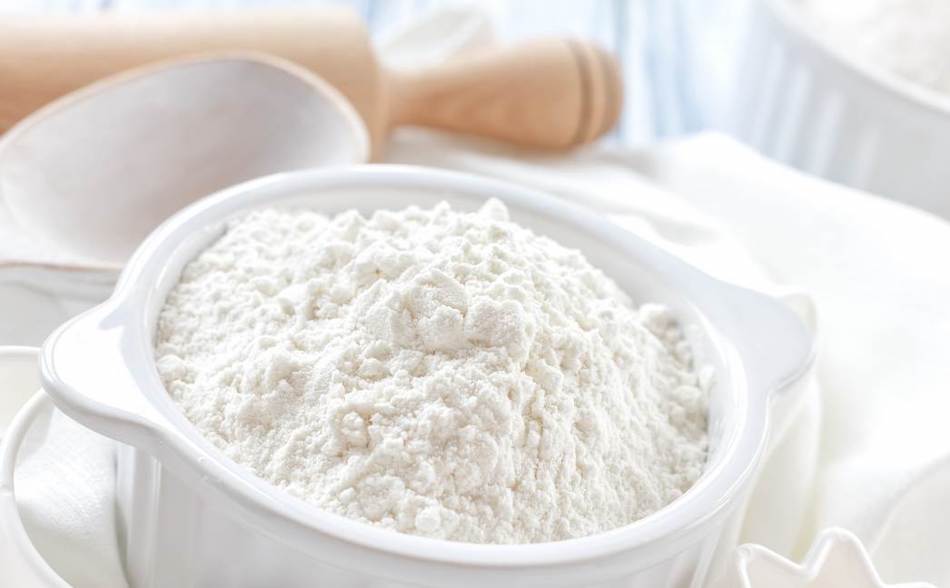
Which Flour Makes the Best Brioche?
The best flour for making brioche is subjective and depends on personal preference and the desired result. Some people prefer the rich and tender texture of brioche made with all-purpose flour, while others prefer the lighter and airier texture of brioche made with bread flour.
Bread flour is ideal for making brioche with a crispy crust and a lighter, airier texture. It is made from hard wheat and has a higher protein content, which helps the dough rise and retain its shape.
All-purpose flour is more versatile and can be used to make brioche with a rich and tender texture. It has a mild flavor that complements the buttery flavor of the brioche.
Cake flour is ideal for making delicate, sweet brioche with a soft and tender texture. It is made from soft wheat and has a lower protein content, which results in a tender and delicate crumb.
Pastry flour is another option for making brioche with a delicate texture. It has a lower protein content than all-purpose flour and is ideal for delicate pastries and sweet breads.
The Most Common Flour to Make Brioche
The most common way to make brioche is with bread flour or all-purpose flour. Bread flour is often used to make brioche because it has a higher protein content, which results in a light and airy texture with a crispy crust.
All-purpose flour is also commonly used because it is more versatile and can produce a rich and tender texture with a mild flavor.
Both of these flours are versatile and can be used to make a variety of brioche recipes, from sweet to savory, and from classic round loaves to individual buns.
How to Achieve the Perfect Brioche Texture with All-Purpose Flour
Brioche is a sumptuous bread that is known for its tender and delicate texture. Achieving this texture requires a combination of the right ingredients and a careful attention to detail during the baking process.
When making brioche with all-purpose flour, it is important to use high-quality ingredients, such as fresh eggs and unsalted butter, and to be mindful of the temperature and consistency of the dough as you work.
To start, you will need to proof your yeast by mixing it with warm milk and a small amount of sugar. After the yeast has activated, you can add in the eggs, salt, and all-purpose flour.
Use a stand mixer or your hands to mix the ingredients together, kneading the dough until it is smooth and elastic. Then, slowly add in the softened butter, working it into the dough until it is fully incorporated.
It is important to allow the dough to rise in a warm, draft-free environment until it has doubled in size. This will help to develop the delicate texture that is characteristic of brioche.
Once the dough has risen, you can shape it into the desired form and let it rise again. Finally, bake the brioche in a preheated oven until it is golden brown and the internal temperature reaches 190°F.
Can You Use All-Purpose Flour to Make Brioche?
All-purpose flour can be used to make brioche. All-purpose flour is a versatile flour that can be used for a variety of baking applications, including making brioche.
The high gluten content in all-purpose flour gives the dough structure and helps to hold the rich ingredients, such as butter and eggs, in place.
When making brioche with all-purpose flour, it is important to use high-quality ingredients and to be mindful of the consistency of the dough as you work to achieve the desired texture.
The Difference Between Brioche All Purpose Flour and Other Methods
The difference between brioche made with all-purpose flour and other methods lies in the type of flour used and the resulting texture and flavor of the bread.
All-purpose flour is a versatile flour that is made from a combination of hard and soft wheat and has a moderate protein content. When used to make brioche, all-purpose flour results in a bread that is tender and delicate with a slightly dense texture.
On the other hand, bread flour, which has a higher protein content, can be used to make brioche and results in a bread with a slightly more chewy texture. Using a combination of bread flour and all-purpose flour is also common and results in a brioche that has the right balance of tenderness and structure.
Finally, some bakers prefer to use pastry flour, which is a type of flour with a low protein content, to make brioche. This results in a particularly tender and delicate bread with a soft, crumbly texture.
The Secret to a Rich and Tender Brioche with All-Purpose Flour
Achieving a rich and tender brioche with all-purpose flour is all about using high-quality ingredients and following proper technique. Here are some secrets to help you achieve the perfect brioche:
- Start with warm, high-quality milk: Using warm milk helps activate the yeast, which is essential for a tender and fluffy brioche.
- Use plenty of butter: Brioche is known for its rich, buttery flavor, so don’t skimp on the butter. Use unsalted butter, and be sure to incorporate it slowly and thoroughly into the dough to ensure even distribution.
- Don’t overmix the dough: Overmixing the dough can result in a tough and dense brioche. Knead the dough until it is smooth and elastic, but not so much that the gluten becomes overdeveloped.
- Let the dough rise properly: Allowing the dough to rise properly is key to a tender and light brioche. Cover the dough and let it rise in a warm, draft-free environment until doubled in size.
- Be patient: Brioche is a time-intensive bread to make, but the results are well worth the wait. Don’t rush the process and allow the dough to rise and develop properly.
All-Purpose Flour Brioche with a Crispy Crust
Achieving a crispy crust on your all-purpose flour brioche requires a few simple steps to ensure the right balance of moisture and heat. Here are some tips to help you achieve the perfect crispy crust:
- Use a well-greased baking dish: A well-greased baking dish will prevent the brioche from sticking and allow for even browning.
- Brush the brioche with egg wash: Brushing the brioche with a beaten egg before baking will help create a golden, crisp crust.
- Place a baking dish filled with water on the bottom rack of the oven: Adding moisture to the oven will help prevent the brioche from drying out and becoming tough.
- Bake at a high temperature: Baking the brioche at a high temperature (375°F or higher) will help create a crispy crust.
The Perfect All-Purpose Flour Brioche Dough Recipe
Ingredients:
- 1/2 cup warm milk (120-130°F)
- 2 1/4 tsp active dry yeast
- 2 large eggs, room temperature
- 2 egg yolks, room temperature
- 3/4 cup sugar
- 1 1/2 tsp salt
- 4 1/2 cups all-purpose flour
- 1 1/2 cups unsalted butter, room temperature, cut into small pieces
- 1 large egg, beaten (for egg wash)
Instructions:
- In a large mixing bowl, whisk together the warm milk and yeast until the yeast has dissolved.
- Add in the eggs, egg yolks, sugar, and salt, and whisk until well combined.
- Gradually add the flour to the bowl, one cup at a time, mixing well after each addition.
- Once the dough has come together, transfer it to a lightly floured surface and knead for 8-10 minutes, or until the dough is smooth and elastic.
- Place the dough in a greased bowl, cover, and let it rise in a warm, draft-free place for 1-2 hours, or until doubled in size.
- Once the dough has risen, transfer it back to the floured surface and punch it down.
- Gradually add the butter to the dough, kneading until well combined.
- Transfer the dough to a greased loaf pan, cover, and let it rise for another hour, or until doubled in size.
- Preheat the oven to 375°F.
- Brush the top of the brioche with the beaten egg.
- Bake for 25-30 minutes, or until the crust is golden brown and the internal temperature of the brioche reaches 200°F.
- Remove the brioche from the oven and let it cool in the pan for 5 minutes before transferring it to a wire rack to cool completely.
How to Shape Brioche with All-Purpose Flour for a Perfect Result
Shaping brioche dough can be a bit tricky, but with a few simple techniques, you can achieve a beautiful, professional-looking result every time. Here are some tips for shaping brioche with all-purpose flour:
- Divide the dough into equal portions: Depending on the desired shape of your brioche, divide the dough into equal portions for each loaf or bun.
- Roll the dough into a ball: For brioche buns, gently roll each portion of dough into a smooth, tight ball.
- Proof the shaped dough: Place the shaped dough on a lightly greased baking sheet and let it rest in a warm, draft-free place for 30 minutes to 1 hour, or until doubled in size.
- Brush the dough with egg wash: Before baking, brush the surface of the brioche with a beaten egg to help create a golden, crisp crust.
- Bake the brioche: Place the baking sheet in the preheated oven and bake until the brioche is golden brown and the internal temperature reaches 200°F.
How to Make Brioche Buns with All Purpose Flour
Here is a basic recipe for making brioche rolls or buns with all-purpose flour:
Ingredients:
- 500g all-purpose flour
- 50g sugar
- 10g salt
- 7g instant yeast
- 4 large eggs, room temperature
- 200g unsalted butter, room temperature
- 1 egg yolk, for egg wash
- Coarse salt, for toppings (optional)
Instructions:
- In a large mixing bowl, whisk together the flour, sugar, salt, and yeast.
- Add the eggs to the dry ingredients and mix until a shaggy dough forms.
- Add the room temperature butter to the dough, a little at a time, and mix until fully incorporated.
- Knead the dough for 10-12 minutes until smooth and elastic.
- Place the dough in a greased bowl, cover with plastic wrap, and let rise in a warm place for 1-2 hours or until doubled in size.
- Once risen, punch down the dough and divide it into 12 equal pieces.
- Roll each piece of dough into a ball and place in a greased muffin tin.
- Cover with plastic wrap and let rise for another 30 minutes to an hour.
- Preheat your oven to 400°F (200°C).
- Brush the tops of the buns with beaten egg yolk and sprinkle with coarse salt (if desired).
- Bake for 20-25 minutes or until the buns are golden brown.
- Remove from the oven and let cool for 10 minutes before serving.
How to Make Brioche Bread with All Purpose Flour
Here is a basic recipe for making brioche bread with all-purpose flour:
Ingredients:
- 500g all-purpose flour
- 50g sugar
- 10g salt
- 7g instant yeast
- 4 large eggs, room temperature
- 200g unsalted butter, room temperature
- 1 egg yolk, for egg wash
Instructions:
- In a large mixing bowl, whisk together the flour, sugar, salt, and yeast.
- Add the eggs to the dry ingredients and mix until a shaggy dough forms.
- Add the room temperature butter to the dough, a little at a time, and mix until fully incorporated.
- Knead the dough for 10-12 minutes until smooth and elastic.
- Place the dough in a greased bowl, cover with plastic wrap, and let rise in a warm place for 1-2 hours or until doubled in size.
- Once risen, punch down the dough and shape into a round loaf. Place in a greased loaf pan.
- Cover with plastic wrap and let rise for another 30 minutes to an hour.
- Preheat your oven to 400°F (200°C).
- Brush the top of the loaf with beaten egg yolk.
- Bake for 25-30 minutes or until the loaf is golden brown and sounds hollow when tapped.

